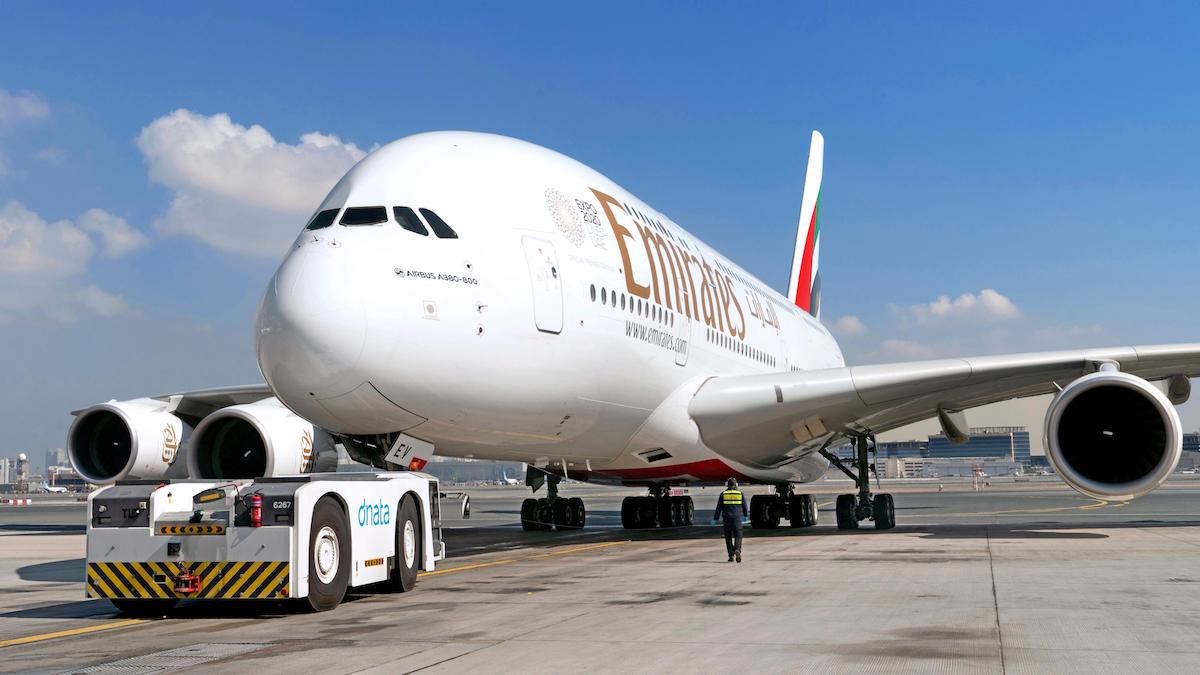Emirates Group has just reported its results for the first half of the financial year (April 1 through October 30, 2020).
Unsurprisingly the airline group is reporting its biggest loss ever, following 32 years of straight profits (or at least that’s what the airline claims).
Emirates’ (unsurprising) record loss
Emirates Group has just shared its financial results for the first half of the financial year, as Emirates Group reported a loss of $3.8 billion, while Emirates Airline reported a loss of $3.4 billion. If my math is right, a $3.4 billion loss comes out to ~$18.6 million per day, ~$775,000 per hour, ~$13,000 per minute, ~$215 per second. Ouch.
Just to clarify the distinction, Emirates Group includes other subsidiaries, like dnata, which is an airport services provider.
 Emirates Airline has reported a $3.4 billion loss
Emirates Airline has reported a $3.4 billion loss
For the most part I’ll be focusing specifically on the results at Emirates Airline, because that’s what I find to be most interesting. As we look at Emirates Airline’s results, keep in mind that the airline had to suspend operations in March per directives from the government, and only restarted operations very gradually after several weeks.
With that in mind:
- Emirates revenue was down 75%, to $3.2 billion
- Emirates capacity shrunk by 91% measured in available seat kilometers
- Emirates capacity shrunk by 96% measured in passenger seat kilometers
- Emirates had an average load factor of 38.6%, compared to 81.1% pre-pandemic
- Emirates carried 1.5 million passengers over six months, down 95% from the same period last year
- Emirates operating costs were reduced by 52%
- Emirates fuel costs were 83% lower compared to the same period last year, due to a combination of a decrease in oil prices (down 49% compared to the same period last year), as well as a 76% decrease in demand due to lack of operations; fuel accounted for 11% of operating costs, compared to 32% of operating costs during the same period last year
- Emirates cargo volume decreased by 35%, while yields increased by 106% (wow)
- Emirates retired only three aircraft over the past six months, though most of the carrier’s fleet continues to be grounded
As far as Emirates Group overall goes:
- Emirates Group has $5.6 billion in cash as of September 30, 2020, compared to $7 billion in cash as of March 31, 2020
- The number of employees at Emirates Group as of September 30, 2020, has been reduced by 24%, to 81,334
 Emirates had an average load factor of under 40%
Emirates had an average load factor of under 40%
Bottom line
Emirates’ losses for the first half of the financial year aren’t surprising, given that this covers the worst of the pandemic so far. Not only did the airline face most of the same challenges as other airlines, but it also dealt with the challenge of having operations suspended for several weeks, as well as being an exclusively international airline.
While Emirates is far from being in the clear, I imagine losses will narrow a bit in the second half of the financial year, as demand for international travel has picked up a bit, and the company has also lowered its costs, including through layoffs.
What do you make of Emirates’ results for the first half of the financial year?




@Lionel PUNDYK
At the risk of over-egging this, you’re simply muddying the waters.
At issue is whether or not strong and manly capitalist corporations should stand on their own two feet, bravely competing in the free market.
Sharon was criticising Emirates for taking government cash, implying it was some sort of evil communist operation unfairly fighting against the noble and pure US airlines.
You’ve ignored all that, and started banging on...
@Lionel PUNDYK
At the risk of over-egging this, you’re simply muddying the waters.
At issue is whether or not strong and manly capitalist corporations should stand on their own two feet, bravely competing in the free market.
Sharon was criticising Emirates for taking government cash, implying it was some sort of evil communist operation unfairly fighting against the noble and pure US airlines.
You’ve ignored all that, and started banging on about what form of state subsidy might or might not be cheaper for government. You may be right. But you’re also accepting what Sharon seems to object to — state-subsidised corporations interfering in the purity of the free market.
My view is that there is not much evidence of a pure free market in aviation: just masses of hidden and not-so-hidden subsidies everywhere you look. Criticising the ME3 in isolation for state support is just evidence of jingoism.
@Ericka well said.. actually it was cheaper this way. As per @the nice paul A clear case of Corporate Socialism. He is learning in the UK
what's sauce for the goose is sauce for the gander.
@Erick
Funny how when the US govt provides subsidy to corporations it’s all above board, and it’s only those damn furriners which are cheating by handing over tax-payer cash...
Sauce... goose... gander?
@the nice guy.
The US government did not gave money to airlinea directly. It was to cover employees payroll. Either that, or you have had people furloughed back in March claiming 600 usd a week plus state unemployment, which was actually more expensive.
Make the numbers. If you are good at it.
It would be interesting to know which routes have decent load factors at this stage of the pandemic.
@Sharon
As opposed to the US government pumping $25 billion (so far) into US airlines?
Dubai’s subsidy seems pretty modest in comparison.
Though the US has always been a world leader at corporate socialism.
Lucky, I think you mean "April 1 through September 30, 2020", otherwise you'd have a 7-month first half.
These losses are not good. But if there’s any airline that will do better than having losses it’s Emirates.
“Oh we lost 4B?”
Dubai government: “here’s some more money, no worries!!”
All fixed. Lol.
Emirates also significantly reduced fuel surcharges for skywards award flights back in May. Yes that's good for us but that's also 'lost' revenue to the airline that's already bleeding as shown by this $3.4 billion loss.
How much more billion to write down the value of the aircrafts?